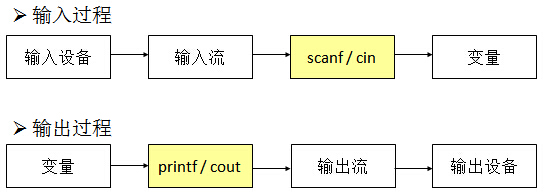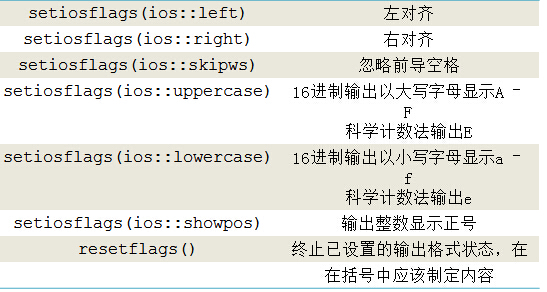新的初始化方法
int x = 1024;
复制初始化(copy-initialization)
如:int x = 1024;
直接初始化(direct-initialization):
如:int x(1024);
注意:
①初始化不是简单地赋值,初始化指声明变量或对象并且赋初值;赋值指用新值覆盖变量或对象当前值。
②直接初始化语法更灵活且效率更高
③初始化内置类型变量两种初始化几乎没有差别对于类类型的初始化,有时只能采用直接初始化(以后讨论)
④两种初始化的方法可以混用(见下例)
合使用初始化的例子:
#include <iostream> using namespace std; int main() { double salary = 9999.99, wage(salary + 0.01); cout<<salary<<" "<<wage<<endl; int interval,month = 8, day = 7, year(2008); cout<<year<<":"<<month<<":"<<day<<":"<<endl; system("PAUSE"); return 0; }
新的I/O
C语言的输入输出:

C++语言的输入输出:

C++语言的输入输出:先睹为快
#include <iostream> using namespace std; int main() { int x; double y; /*以下语句等价于printf("请输入两个整数(用逗号隔开):");*/ cout << "请输入两个整数(用空格隔开):"; /*以下语句等价于scanf("%d %f", &x, &y);*/ cin >> x >> y; /*以下语句等价于printf("x = %d, y = %f ", x, y);*/ cout << "x = " << x << ", y = " << y << endl; system("PAUSE"); return 0; }
C++的输入输出:cin,cout的用法
cout<<表达式1<<表达式2<<表达式n;
cin>>变量1>>变量2>>变量n;
cout<<"x + y ="<< x + y << "." << endl; cin >> x >> y;
[注意]
①不能用一个<<输出多个数据项
cout<<a,b,c<<endl; /*错误*/ cout<<a<<b<<c<<endl; /*正确*/
②cin/cout可以分成多行来写
cin>>a>>b >>c; cout<<a<<b <<c;
cout的用法举例:
#include <iostream> using namespace std; int main() { cout << "This is a C++ program! " << endl; cout << "This is" << " a C++" << "program!" << endl; system("PAUSE"); return 0; }
cin的用法举例:
int main() { char c1, c2; int a; float b; cin >> c1 >> c2 >> a >> b; cout << "c1 = " << c1 << endl << "c2 = " << c2 << endl << "a = " <<a << endl << "b = " << b << endl; system("PAUSE"); return 0; }
cout与输出控制字符:
#include <iostream> #include <iomanip> using namespace std; int main() { int x = 0; cout << "请输入一个八进制整数(以开始):";
cin >> oct >> x; cout << "x的十六进制表示为:" << hex << x << endl; cout << "x的十进制表示为:" << dec << x << endl; cout << "x的八进制表示为:" << oct << x << endl; system("PAUSE"); return 0; }
输出控制符:


注意:若用控制符,程序需包含头文件#include<iomanip>
有关类型的区别
有关类型的区别:bool类型
|
逻辑类型 |
真 |
假 |
|
|
C |
没提供 |
非0 |
0 |
|
C++ |
bool |
true |
false |
注意:
1)bool类型的取值只有两种true,false
2)输出时默认输出0或者1
3)用boolalpha可以改变默认的输出方式,noboolalpha可以恢复默认的输出方式
#include <iostream> using namespace std; int main() { bool bval1 = 1 < 2; bool bval2 = true; bool bval3 = false; bool bval4 = 4; bool bval5 = 0; cout << "bval1=" << bval1 << endl; cout << "boolalpha bval1=" << boolalpha << bval1 << endl; cout << "noboolalpha bval1=" << noboolalpha << bval1 << endl; cout << "bval2=" << bval2 << endl; cout << "bval3=" << bval3 << endl; cout << "bval4=" << bval4 << endl; cout << "bval5=" << bval5 << endl; system("PAUSE"); return 0; }
有关类型的区别:string类
#include <iostream> #include <string> using namespace std; int main() { string name = "student"; string address = "Hebei... ..."; cout << name << address <<endl; return 0; }
string对象的定义和初始化:
|
初始化string对象的方式 |
|
|
string s1; |
默认构造函数,s1为空串 |
|
string s2(s1); |
将s2初始化为s1的一个副本 |
|
string s3("value"); |
用字符串字面值初始化s3 |
|
String s4(n,'c') |
将s4初始化为字符'c'的n个副本 |
#include <iostream> #include <string> using namespace std; string s0; int main( ) { string s1; //string s2 = "hello world!"; string s2("hello world!"); //string s3 = s2; string s3(s2); string s4(5, 'r'); cout << "s0=" <<s0 <<endl; cout << "s1=" <<s1 <<endl; cout << "s2=" <<s2 <<endl; cout << "s3=" <<s3 <<endl; cout << "s4=" <<s4 <<endl; system("PAUSE"); return 0; }
string对象的读写:用cin、cout读写string对象
注意:
cin忽略开头所有空格、TAB、回车符
不接收含空格的字符串
string的I/O:
#include <iostream> #include <string> using namespace std; int main() { string s; cin >> s; //hello world! cout << s <<endl; //hello system("PAUSE"); return 0; }
string读入未知数目的对象:
#include <iostream> #include <string> using namespace std; int main() { string word; while(cin >> word) cout << word << endl; system("PAUSE"); return 0; }
string对象的读写:用getline读取整行文本(含空格)。
#include <iostream> #include <string> using namespace std; int main() { string line; while(getline(cin, line)) cout << line << endl; system("PAUSE"); return 0; }
注意:
getline的第一个参数通常为cin, 第二个参数为string对象
从录入数据的下一行读取,可读取 任何字符
getline()以回车作为结束符 (不接受换行符)
getline()不忽略前导回车,若第一 个就是换行符,则置为空串
|
string的操作 |
|
|
s.empty() |
若s为空串,则返回true,否则返回false |
|
s.size() |
返回s中字符的个数 |
|
s[n] |
返回s中位置为n的字符,位置从0开始 |
|
s1+s2 |
将两个串连接成新串,返回新生成的串 |
|
s1 = s2 |
把s1得内容替换为s2的副本 |
|
v1 == v2 |
判定时候相等,相等返回true,否则返回false |
|
!= < <= > >= |
保持这些操作惯有的含义,如:s != s2; |
注意:
1、size()的返回类型并非int而是string::size_type类型的值,建议不要把size()的返回值赋值给int变量
string s2 = "hello"; string::size_type count = s2.size();
#include <iostream> #include <string> using namespace std; int main() { string s1 = "hello"; string s2 = "world"; string s3 = s1 + ","; string s4 = "hello" + "world "; //error string s5 = "hello" + s2 + "world" ; system("PAUSE"); return 0; }
4、string下标操作可用作左值
int main() { string str = "student"; cout << str << endl; for(string::size_type ix = 0; ix!=str.size(); ++ix) str[ix] = 'x'; cout << str << endl; system(" PAUSE "); return 0; }
有关类型的区别:枚举
C++对枚举的改进:
①在C++中定义枚举变量可以不用enum
enum weekday {sun, mon, tue, wed, thu, fri, sat}; weekday w; //省略了enum
②无名枚举:不给出枚举类型名和变量,将枚举元素当符号常量用
enum {min = 0, max = 100}; int x = min, arr[max];
... ...
有关类型的区别:union
C++对联合的扩展:
①无名联合:没有联合体类型名和变量名的联合体
#include <iostream> using namespace std; int main() { union { char c; int i; double d; }; c = 'a'; cout << c << endl; return 0; }
②定义联合变量无需给出union
#include <iostream> using namespace std; union test { char c; int i; double d; }; int main() { test m = {'a'}; cout << m.c << endl; return 0; }
有关类型的区别:struct
C++对结构体的扩展
①定义结构体变量可以不用struct
struct point { double x; int a; }; point p;
②成员可以包含函数定义
struct point{ double x,y; //数据成员 void setvalue(double a,double b) //成员函数 { x = a; y = b; } };